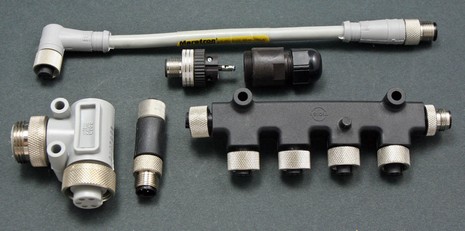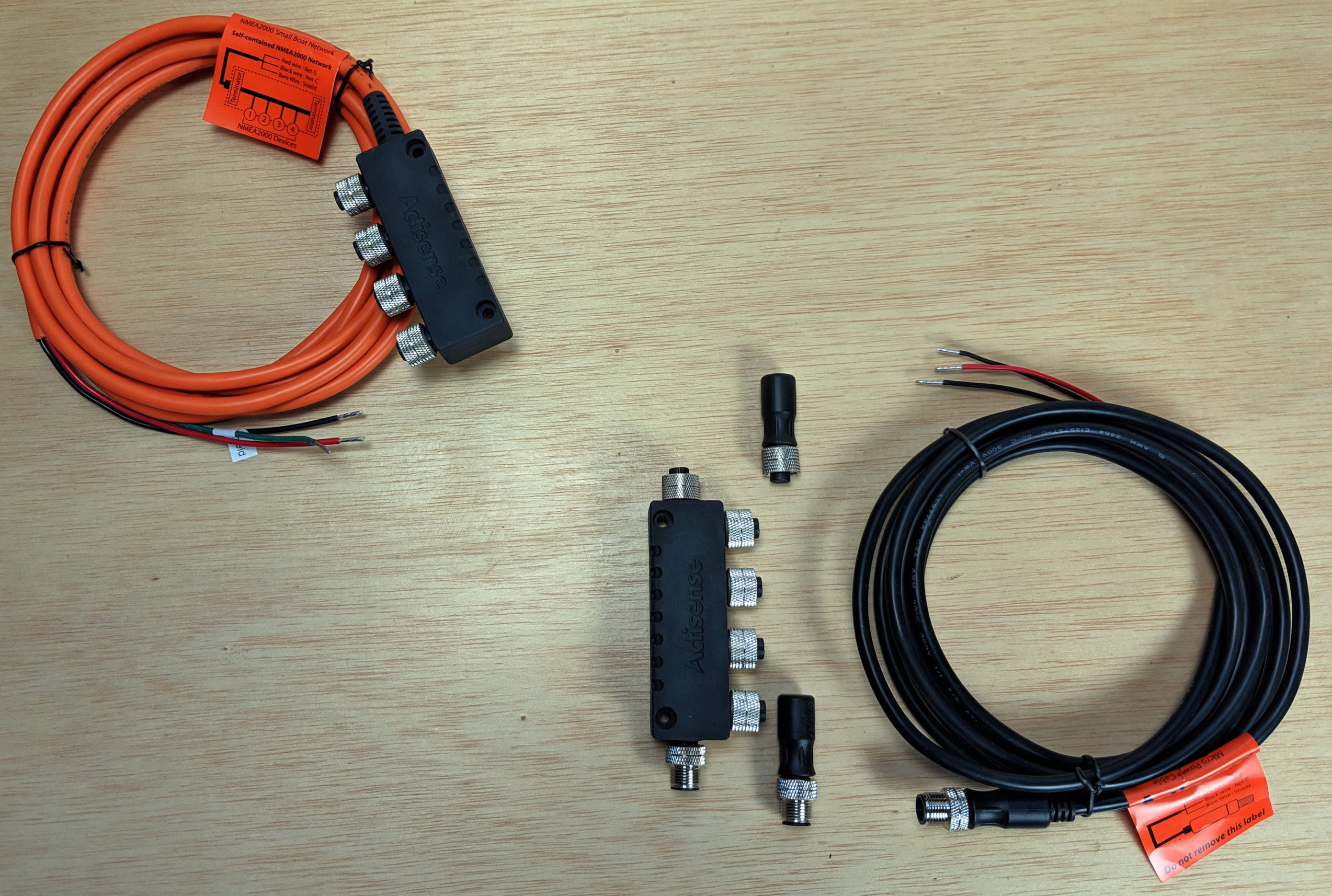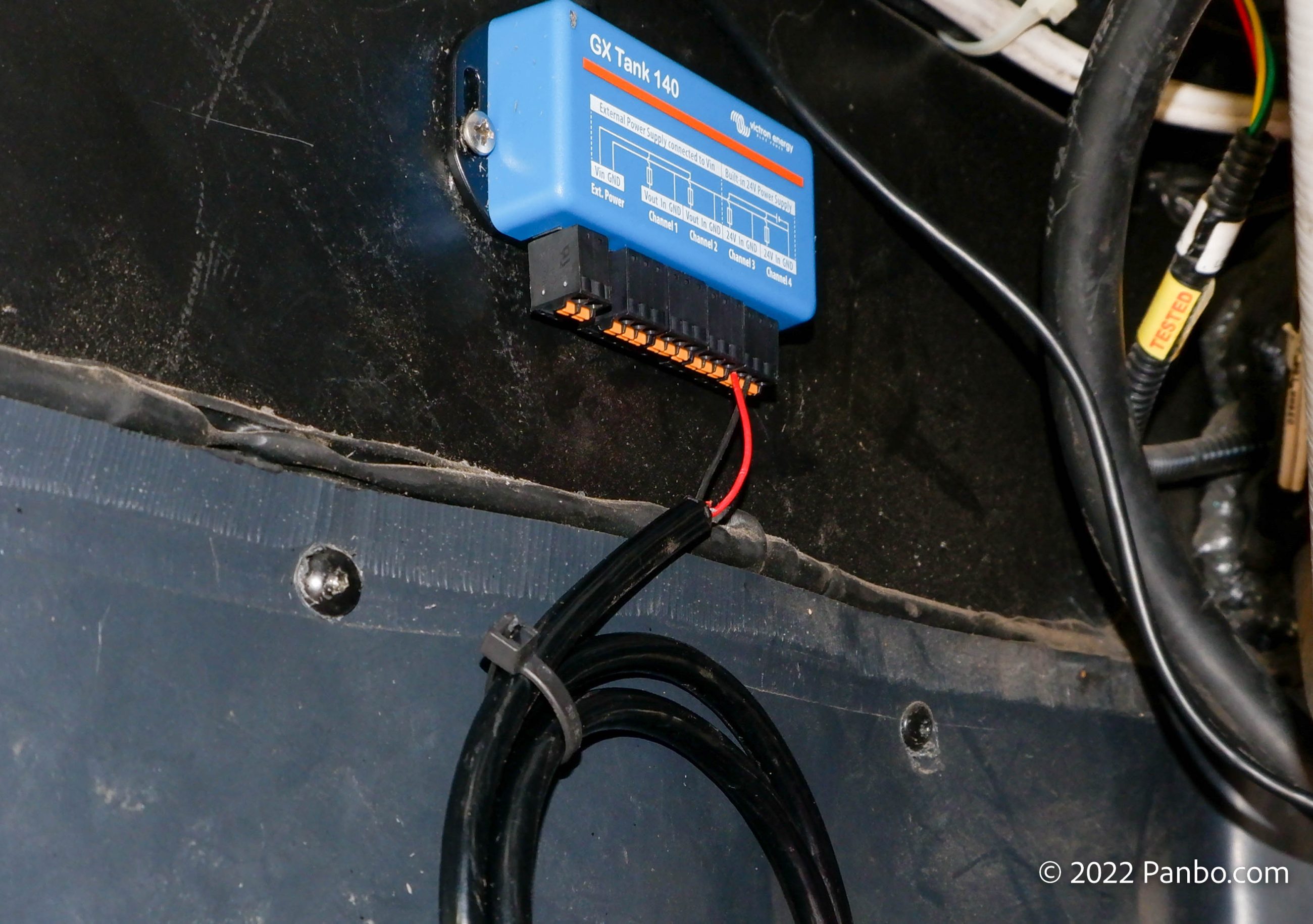New N2K doodads, easier cabling

In addition to the tank/rudder adapters I tried, Maretron sent over some new cabling parts of interest. Let’s check out the big picture, starting with the four way tee at lower right. It’s quite like the Double T that Lowrance recently introduced—though obviously better made (metal threads!), and probably more expensive—and it’s obviously useful in tight areas where you want to tee off numerous sensors and/or displays. To its left is a possibly more valuable inline terminator.
Every N2K backbone has to have a resistor at each end, and tee drops can only be about 16 feet maximum. Therefore a smart backbone design might start at the masthead or tuna tower, then snake down to the bow, and finally to the engine room. But up until now that meant that, say, a masthead N2K weather sensor had to have a nearby tee and terminator…awkward. Now you can just screw the “inline” between the sensor and backbone…done.
The new right angle connector at bottom left is the only part here belonging to the Mini size cabling system, as opposed to the much more common Micro size. It’s big stuff, but note that on bigger boats it may make sense to use this as a backbone even if the tees are mostly converted down to Micro size (easily done). That’s because the Mini size will carry twice the amperage—8 amps instead of 4 on each side of the power drop—and those figures are maximums. A properly designed N2K backbone is analyzed for potential voltage drops and max loads may be lowered as a result.
At top is a short right angle Micro cable, another useful part in tight installs, and finally I put in a field installable” Micro plug, which is not new but good to know about. I haven’t tried one, but they look well made and I know the chief installer at Lyman Morse (Electra has a Maretron Weather Station and Display) likes them a lot. By the way, while all these parts are available from Maretron, they are manufactured by the connector specialists Molex and Brad Harrison (remember that the N2K cabling standard is also called DeviceNet and is used in other industries). And note that while Panbo may be all NMEA 2000 this week, the really big news will have to wait until the end of the month!
PS 10/4: Here’s Maretron’s price list; I think you’ll find that the cabling prices are fairly similar to those of proprietary N2K and Ethernet cables from Raymarine, Garmin, and others. Another useful document is the Maretron N2K Designer’s Guide downloadable at the top of this page.













have you priced the cabling pieces? that stuff is normally sold for factory automation and it *pricey*. given the captive audience and the modest volumes, i suspect the prices will not go down dramatically very soon.
Do you think in a few years NMEA 0183 devices will all go the way of dinosaurs and the Commodore PC.
I am constantly tossing out hi tech gear which is no longer supported. First we had floppies, then zips drive, then CDs now flash drives. Can even find a zip drive reader these days it seems.
Technology is marching very fast but who can afford to replace their gear to stay current at this rate?
Def, No I don’t think NMEA 0183 will go away soon. What I’m seeing, and liking, is that MFDs by Raymarine, Simrad, and possibly others take any 0183 data they’re getting and bridge it up to NMEA 2000 and even Ethernet if it’s not already present on those pipes.
Ben,
I received my November “Lattitudes and Attitudes” magazine yesterday. There is an article by Alex Morton called “The Google Sailor” which is real interesting. He talks about using Google Earth to do future charting and how it could be particularly useful for harbor entrance.
Good read. Might be looking at the future here.
I sent you a note agreeing with your comment about common cabling for equipment so that every time you change a radio with a remote cable (within the same manufacturer) you don’t have to change the cable. Well the same applies to Radar and I’m sure other stuff. Last year I was thinking about upgrading my 1830 Furuno radar but was stopprd in my tracks by the need to run new cabling up the mizzen through the engine room, etc. Forget it.
How about a universal cable that has 16 wires or so to work with radars that need 12,14,or 16.
The guys that design these great devices need a bit of time installing them.
All this my be made moot by wireless someday.
By the way, “Herbs Channel”( Herb Hilgenberg) @ 12.359 USB is a good listen at 2000 UCT. Listen for calls to “Southbound II”.
Ray
Finally deceided to go for a Garmin wind sensor and GMI 10 display after my Simrad IS12 wind sensor gave up. My sail yacht has a Simnet cabling system with terminated back bone in the masthead. Since Garmin comes with NMEA 2000 cabling I need an adapter between the new wind sensor and the Simnet cable in the masthead. Is there a limit how long the cable lenght can be between the terminator and the wind sensor.
Jens, I’m not sure if the termination of your present SimNet backbone is built into the end of the mast cable or the IS12 wind sensor itself. And neither the SimNet install manual nor the IS20 manual is very clear on the subject. Maybe you or someone else knows for sure?
At any rate, I think the general rule of thumb is that a cable section beyond an inline terminator or coming from a tee which is terminated is considered a drop and shouldn’t be longer than 6m.
So you need a SimNet tee and a SimNet-to-NMEA2000 female patch cable, and maybe an inline terminator or a SimNet terminator you plug into that tee. But it all sounds a bit messy for masthead installation. (Unfortunately, because SimNet connectors are sexless, there’s no way to simply patch directly without a tee.)
I’d sure be considering replacing the IS12 wind sensor and just adding the GMI 10 as an alternate way to see the wind. That should work fine, though you’ll still need the IS12 instrument to calibrate the SimNet sensor.
PS I may be wrong about SimNet inline joiners. I’ve never seen one in the flesh, but they’re listed here:
http://www.simrad-yachting.com/Products/Accessories/SimNet/SimNet-Joiners/